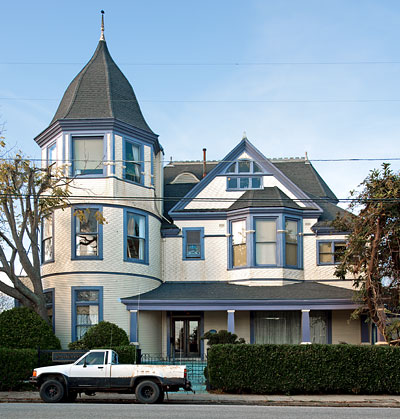National Register of Historic Places in Santa Cruz County
Golden Gate Villa
924 3rd Street
Santa Cruz
Built 1891
Golden Gate Villa, designed by Thomas J. Welch of San Francisco, was built as a summer home for Major Frank W. McLaughlin, who named it after one of his mining ventures in Oroville.
The residence has three stories, a full basement, an attic, two full towers and one half-tower. The main tower was the highest point in Santa Cruz at the time of the villa's completion and was dedicated to the fathers of Mission Santa Cruz.
The building, an outstanding example of the eclectic Queen Anne style, recalls the opulence of Beach Hill as a resort area in early Santa Cruz. The district boasted several such villas and hotels, among them the Sea Beach Hotel; however, only the Golden Gate Villa remains as a reminder of an era and an architectural style.
Major McLaughlin, a protege of Thomas Edison, came to Oroville with $500,000 of Edison's money to purchase black sand areas around the town, thinking that the material would provide the necessary filaments for Edison's electric light bulb. When tungsten proved more efficient, McLaughlin was instructed to invest the money in surrounding gold mines.
McLaughlin began construction of a $12 million "Chinese Wall" along the Feather River above Oroville, with the intention of diverting the river to reach the rich deposits of gold which supposedly lay beneath its waters. In pursuit of this project, he sailed to England, was received at the Court of St. James, and returned to the States with the necessary financial backing.
Overnight, Oroville became the mining center of the world. A tremendous electric plant, the first large scale commercial plant of its kind in the world, was installed with Edison's assistance, so that the men could work night and day. However, once the waters had been diverted, it was discovered that the river had already been mined of its gold during the '49 Gold Rush, and in 1897 the project folded in bankruptcy.
Among McLaughlin's other gold mining projects were a tunnel nine miles long for the Big Bend project, the Miocene Hydraulic Mine with its thirty miles of flume, and the United States Hydraulic Mine at Cherokee, with its inverted siphons and nine inch nozzles that sprayed forty million gallons of water a day against the mountainside.
With McLaughlin's death by suicide, one of the most colorful eras in gold mining came to an end.
Excerpted from the NRHP Nomination.
